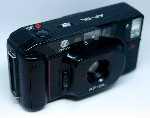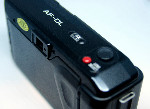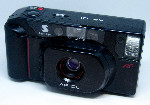My first post about a fully-automatic, compact camera, the Minolta AF-DL, is it automatically good, or automatically rubbish?
Standby solution
Minolta AF+DL
Camera: £1.80
Postage: £3.50
Total: £5.30
full specs
I had bought a few compact auto cameras intending to try them all out at one point, largely because they were available very cheaply. The Minolta AF-DL was the first one I got around to trying out with a film.
Seeing clearly
The AF in the name refers to Auto Focus, which was quite a luxury at first. Typically autofocus is very useful, as it’s pretty rare that want to take a picture out of focus – the only difficulty arises is when there is a choice of things to focus on and the camera isn’t clever enough to show you which one. The Minolta AF-DL has a little trick up its sleeve – as it has centre-weighted focus and a focus-lock control. In practice that means you centre the thing you want to focus on, half-press the shutter, and then re-aim the camera to get the shot you want. It’s a clever way to get around the limitation and has been used in a great many cameras since.
Seeing double
The DL in the name refers to the Dual Lens. Released in 1987 it was around the time that all cameras seemed to be moving from fixed lenses to zoom lenses – it was what the public wanted. Rather than follow the crowd, Minolta offered a sort of halfway-house with a choice of two fixed zoom levels to choose from, 35mm and 50mm – a wide and a regular view. Looking back now, it was a great decision. Fixed-lens compact cameras from the era are now in high demand for their superior image quality, whereas zoom lens examples are held in rather low esteem, often with good reason.
Just press button
Using the Minolta AF-DL is simple, the lens cover functions as an on-off switch, one button switches between the lenses and the only other button fires the shutter. The aperture is fixed depending on the lens selected and the shutter speed, winder and flash are all automatic.
It automatically senses films speed using DX coding, but can only recognise 100 or 400 ISO film and has no manual film speed override. This can be a problem with these types of cameras – you need to select standard film speeds in standard canisters – you wan’t be able to use uncommon film types or film you’ve rolled yourself from a big reel.
It needs batteries of course and rather unsually offers a choice – a longer-lasting DL223A or four far-more-widely-available AAAs.
It’s all fun and games until…
It was fun and easy to shoot with, until the first surprise came along. I don’t know if there was something wrong with the film cansiter, as it had jammed in the Diana after only six shots, but after a dozen or so shots in the Minolta AF-DL, the film broke inside the camera.
I can’t remember exactly how I got the film out of the camera, or got it back into the canister, or how I sent it off to be processed. It was also around this point that I noticed I’d put Fuji 800 ISO in, which the camera would not have recognised. I sent it off to Ag Photo in Birmingham and they handled it brilliantly.
Let’s have a look, then
Fuji Xtra 800
Cost: £3.05
Postage: £0.70
ISO: 800
Format/Type: Colour Negative
Exposures: 24
Processing: £2.99
Full Total: £7.64
Cost per shot: £0.32
My Rating: 6
It’s definitely a film I’d use again and I’d try shooting it at a slower speed again too – although the next time not by accident.
The camera though, despite the clear shots it delivered is one I’d have to think twice about reusing. Tearing the film in half is a bit of a no-no and I’d have to do some testing to make sure it was a one-off.














